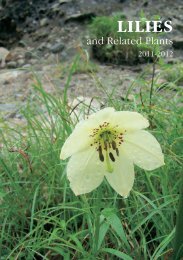LILIES - RHS Lily Group
LILIES - RHS Lily Group
LILIES - RHS Lily Group
Create successful ePaper yourself
Turn your PDF publications into a flip-book with our unique Google optimized e-Paper software.
Groves of northern forests<br />
Very close to the hot and sunburnt sands, one can move into the cool shade of<br />
alder forest, under a dense canopy of black alder (Alnus glutinosa). Black alder<br />
communities produce a refuge for many rare and relic plants penetrating to the<br />
south from northern forests. Here you can find thickets of rare ferns. There are<br />
also interesting sedges, rare Veratrum lobelianum, Geum aleppicum and other<br />
unusual plants for that territory, including orchids and bulbs.<br />
Relic lakes<br />
On the sandy floodland terrace of the left side of Kumilga river along the borders<br />
of this sand massif there is a chain of small lakes with a set of rare and interesting<br />
species, many of them came from the north with the glacier and stayed to live<br />
here after it had melted. Here one can find extremely rare Lycopodiella inundata,<br />
and also Menianthes trifoliata, Comarum palustre, white moss Sphagnum and<br />
other plants that are unusual on the steppes. There are also some very rare<br />
orchids, such as Orchis militaris.<br />
Floating islands<br />
Large Babinsky and Small Babinsky Lakes in the environs of stanitsa Alexeevskaya<br />
(named after son of Peter the Great, tsarevich Alexej) are interesting as they have<br />
floating islands (Byalt, Firsov, Sidorov, 2006). Their base is formed by roots of<br />
Phragmites altissimus and there is a real forest growing on these islands with<br />
Betula pubescens and Populus tremula, up to 10 m high and 15-18 cm in trunk<br />
diameter. Islands reach considerable sizes to one hectare and more. In windy<br />
weather they travel from one bank to another. The island may stand near the<br />
bank for a long time, but if the wind changes direction, the island easily travels<br />
to the opposite shore, the trees forming a natural sail. This may frighten the odd<br />
fisherman. It is interesting to have an excursion on such an island as it seems that<br />
you are in real forest but with ones feet dropping into the mossy soil and having<br />
to move with great care, pushing through the large fern Thelypteris palustris and<br />
avoiding the open “windows” of water, fallen twigs and trunks of birches that<br />
have been cut off by beavers. On the island are beautiful flowering herbs such<br />
as Inula helenium and Calystegia sepium but we were not able to discover bulbs<br />
due to the very wet and boggy conditions on the islands. The bulbous plants not<br />
being adapted to stand very wet and boggy places.<br />
Seasonal changes<br />
The profuse flowering of numerous small white flowers of Spiraea crenata and<br />
S. litwinowii, together with pinkish steppe almond (Amygdalus nana), and<br />
white wild plum (Prunus spinosa), shrubby wild cherry (Cerasus fruticosa) gives<br />
the unforgettable picturesque appearance to the spring steppe. In a short time<br />
the steppe changes completely, there is a honey smell all around. There are<br />
112




